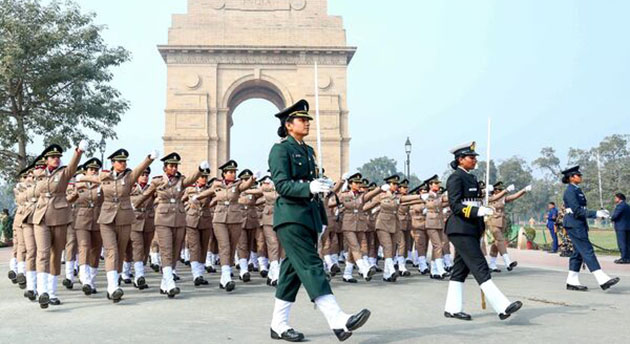
New Delhi: India ushered in its 75th Republic Day on Friday with a grand display of its women power and military might that included elite marching contingents, missiles, warplanes, surveillance gadgets and lethal weapon systems, with French President Emmanuel Macron gracing the occasion as the chief guest.
For the first time, an all-women tri-services contingent marched down the Kartavya Path, reflecting the country's growing 'Nari Shakti' (women power).
In another first, the parade was heralded by over 100 women artistes playing Indian musical instruments such as sankh, naadswaram and nagada instead of traditional military bands kickstarting the celebrations.
The parade commenced with President Droupadi Murmu taking the salute shortly after she and Macron, flanked by the Indian president's bodyguards, arrived at the Kartavya Path in a 'traditional buggy'.
Prime Minister Narendra Modi, Defence Minister Rajnath Singh, several other Union ministers, the country's top military brass, foreign diplomats and senior officials were among the spectators at the biggest event on Kartavya Path, the centrepiece boulevard of the national capital.
The first Army contingent leading the mechanised column was the 61 Cavalry which was raised in 1953. It was followed by 11 mechanised columns, 12 marching contingents and a fly-past by advanced light helicopters of the Army Aviation Corps.
Tank T-90 Bhishma, NAG missile systems, infantry combat vehicles, all-terrain vehicles, weapon locating radar system 'Swathi', drone jammer system, and medium-range surface-to-air missile were among the key displays by the mechanised columns.
The all-women tri-service contingent, led by Captain Sandhya of Army Military Police, with three supernumerary officers Captain Sharanya Rao, Sub Lieutenant Anshu Yadav and Flight Lieutenant Shrishti Rao drew huge applause.
Another all-women Armed Forces Medical Services contingent, headed by Major Srishti Khullar with Captain Amba Samant of the Army Dental Corps, Surgeon Lieutenant Kanchana of the Indian Navy and Flight Lieutenant Dhivya Priya of the Indian Air Force also marched down the ceremonial boulevard.
The Army's marching contingents included the Madras Regiment, the Grenadiers, the Rajputana Rifles, the Sikh Regiment and the Kumaon Regiment.
The Indian Navy's contingent consisted of 144 men and women Agniveers, led by Lt Prajwal M as contingent commander and Lt Mudita Goyal, Lt Sharvani Supreiya and Lt Devika H as platoon commanders.
It was followed by a naval tableau, depicting the themes 'Nari Shakti' and 'Sea Power Across the Oceans Through Indigenisation'.
The first part of the tableau showcased the women in the Indian Navy in all roles and ranks, while the second part depicted the very first indigenous Carrier Battle Group, comprising aircraft carrier INS Vikrant, her highly capable escort ships Delhi, Kolkata and Shivalik and the Kalvari class submarine and Rukmani satellite among others.
The Indian Air Force contingent comprised 144 airmen and four officers, and it was led by Squadron Leader Rashmi Thakur. Squadron Leaders Sumita Yadav and Pratiti Ahluwalia and Flight Lieutenant Kirti Rohil were the supernumerary officers.
The IAF tableau was themed 'Bharatiya Vayu Sena: Saksham, Sashakt, Aatmanirbhar'.
The tableau depicted LCA Tejas and Su-30 flying over the Indian Ocean Region and a C-295 transport aircraft being flown by women aircrew in the cockpit.
The GSAT-7A positioned on the tableau represented the IAF's incorporation of space technology in its operations.
The tableau showed that IAF has been at the forefront of rendering humanitarian aid, both within and across borders.
Another highlight of the parade was the veterans' tableau on the theme 'Rashtra Nirmaan: Pehle Bhi, Ab Bhi, Aage Bhi aur Hamesha'. It showcased the bravery and sacrifices of the ex-servicemen towards the nation.
In its tableau, the Defence Research and Development Organisation (DRDO) displayed many home-grown critical systems and technologies developed by it.
The tableau was based on the theme of women power in protecting the nation by providing the defence shield in all the five domains of land, air, sea, cyber and space.
Outstanding scientist Sunita Devi Jena was the contingent commander, with P Laxmi Madhavi, J Sujana Choudhary and A Bhuvaneswari also present on the tableau.
The tableau displayed a man-portable anti-tank guided missile, anti-satellite missile, Agni-5, surface-to-surface ballistic missile, very short range air defence system, naval anti-ship missile'short range (NASM-SR) and anti-tank guided missile 'HELINA'.
Quick reaction surface-to-air missile (QRSAM), Astra, Light Combat Aircraft 'Tejas', Uttam active electronically scanned array radar (AESAR), advanced electronic warfare system and Shakti Cyber Security systems were also on display.
The themes of the celebrations were -- 'Viksit Bharat' and 'Bharat -- Loktantra Ki Matruka' (India--Mother of Democracy). A 95-member marching contingent and a 30-member band contingent from France also took part in the parade.
Two Rafale fighters and an Airbus A330 multi-role tanker transport aircraft of the French air force also featured in the celebrations.
The celebrations ended with a jaw-dropping flypast by 46 aircraft of the Indian Air Force.
The IAF fleet included 29 fighter jets, seven transport aircraft, nine helicopters and one heritage plane. All these aircraft operated from six different bases.
Fifteen women pilots, including six from the fighter streams, operated the IAF platforms during the fly-past.
For the first time, indigenously-built Tejas aircraft flew in a formation of four aircraft.
There was a previous occasion of one Tejas jet being part of the Republic Day parade but this was the first time that the aircraft flew in a formation.






Comments
Add new comment